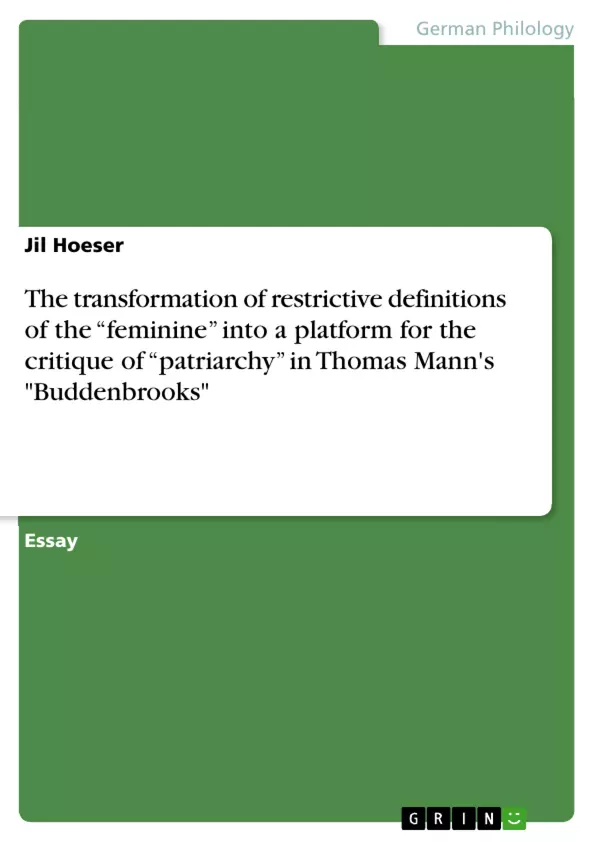The common definition of femininity as 'having characteristics that are traditionally thought to be typical of or suitable for a woman’ will play an important role in the following essay. To discuss the topic of this paper, I am using Thomas Mann’s best-selling novel ‘Buddenbrooks’ to try to analyse it from these different points of view. To examine the aspects of femininity, I will mainly focus on Antonie Buddenbrook, called Tony, and her brother Thomas, as they are from the same generation and are playing an important role from the beginning of the novel until its very end.
First of all, I will start by trying to give a clear outline of what feminine or femininity is. After seeing some definitions and also paying attention to what women were supposed to be in the 1800’s, we will see in what way they can be called restrictive. Of course, I also need to have a further look into the principle of the so-called patriarchy. To see if Thomas Mann can transform the restrictive definitions of the feminine from his novel into a platform for the critique of patriarchy, I will analyse the two main characters of his novel after the first theoretical part.
This work can be seen as quite important as I will try to see if there is a connection between femininity and the decline of the ‘Buddenbrooks’. Hopefully this will enlighten us on how Thomas Mann did or did not describe a critique towards patriarchy in his first novel.
Inhaltsverzeichnis (Table of Contents)
- Femininity
- The Restrictive Definitions of Femininity
- The Concept of Patriarchy
- The Buddenbrooks
- Antonine Buddenbrook
- Thomas Buddenbrook
- The Decline of the Buddenbrooks
- Conclusion
Zielsetzung und Themenschwerpunkte (Objectives and Key Themes)
This essay aims to explore the concept of femininity and its restrictive definitions in the context of Thomas Mann's novel "Buddenbrooks." By analyzing the characters of Antonie Buddenbrook and her brother Thomas, the essay seeks to determine whether Mann's work transforms these restrictive definitions into a platform for critiquing patriarchy.
- The concept of femininity and its historical evolution
- The restrictive nature of traditional gender roles
- The concept of patriarchy and its influence on society
- The portrayal of women in the bourgeois society of the late 19th century
- The relationship between femininity and the decline of a family dynasty
Zusammenfassung der Kapitel (Chapter Summaries)
The essay begins by defining femininity and examining the historical context of its restrictive definitions. The author explores various perspectives on femininity, including those of Sandra Dee, Diane Baker, and Simone de Beauvoir. Judith Butler's theory of performativity is then introduced, arguing that gender is not a fixed identity but a performance. This leads to a discussion of the restrictive nature of traditional definitions of femininity, which often portray women as the 'Other' of masculinity.
The essay then shifts to analyzing the portrayal of women in the bourgeois society of the late 19th century, focusing on the experiences of Antonie Buddenbrook in Thomas Mann's "Buddenbrooks." The author examines the social expectations and limitations placed on women in this period, highlighting their societal roles and their restricted opportunities for personal fulfillment.
The essay concludes by exploring the relationship between femininity and the decline of the Buddenbrook family. The author examines how the characters' choices and actions, shaped by societal expectations and gender roles, contribute to the family's eventual downfall.
Schlüsselwörter (Keywords)
The key terms and concepts explored in this essay include: femininity, patriarchy, gender roles, bourgeois society, restrictive definitions, performativity, social expectations, and the decline of the Buddenbrooks family.
- Quote paper
- Jil Hoeser (Author), 2016, The transformation of restrictive definitions of the “feminine” into a platform for the critique of “patriarchy” in Thomas Mann's "Buddenbrooks", Munich, GRIN Verlag, https://www.grin.com/document/335475



